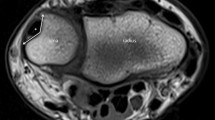Abstract
Objective
The purpose of this study was to evaluate the association between distal ulnar morphology and extensor carpi ulnaris (ECU) tendon pathology.
Materials and methods
We retrospectively reviewed 71 adult wrist MRI studies with ECU tendon pathology (tenosynovitis, tendinopathy, or tear), and/or ECU subluxation. Subjects did not have a history of trauma, surgery, infection, or inflammatory arthritis. MRI studies from 46 subjects without ECU tendon pathology or subluxation were used as controls. The following morphological parameters of the distal ulna were measured independently by two readers: ulnar variance relative to radius, ulnar styloid process length, ECU groove depth and length. Subjects and controls were compared using Student’s t test. Inter-observer agreement (ICC) was calculated.
Results
There was a significant correlation between negative ulnar variance and ECU tendon pathology (reader 1 [R1], P = 0.01; reader 2 [R2], P < 0.0001; R1 and R2 averaged data, P < 0.0001) and ECU tendon subluxation (P = 0.001; P = 0.0001; P < 0.0001). In subjects with ECU tendon subluxation there was also a trend toward a shorter length (P = 0.3; P <0.0001; P = 0.001) and a shallower ECU groove (P = 0.01; P = 0.03; P = 0.01; R1 and R2 averaged data with Bonferroni correction, P = 0.08). ECU groove depth (P = 0.6; P = 0.8; P = 0.9) and groove length (P = 0.1; P = 0.4; P = 0.7) showed no significant correlation with ECU tendon pathology, and length of the ulnar styloid process showed no significant correlation with ECU tendon pathology (P = 0.2; P = 0.3; P = 0.2) or subluxation (P = 0.4; P = 0.5; P = 0.5). Inter-observer agreement (ICC) was >0.64 for all parameters.
Conclusion
Distal ulnar morphology may be associated with ECU tendon abnormalities.








Similar content being viewed by others
References
Crema MD, Marra MD, Guermazi A, Roemer FW, Bohndorf K, Jomaah N. MDCT arthrography features of ulnocarpal impaction syndrome. AJR Am J Roentgenol. 2009;193:1376–81.
Sachar K. Ulnar-sided wrist pain: evaluation and treatment of triangular fibrocartilage complex tears, ulnocarpal impaction syndrome, and lunotriquetral ligament tears. J Hand Surg Am. 2008;33:1669–79.
Schuind F, Eslami S, Ledoux P. Kienbock’s disease. J Bone Joint Surg Br. 2008;90:133–9.
Czitrom AA, Dobyns JH, Linscheid RL. Ulnar variance in carpal instability. J Hand Surg Am. 1987;12:205–8.
Jeantroux J, Becce F, Guerini H, Montalvan B, Le Viet D, Drapé J-L. Athletic injuries of the extensor carpi ulnaris subsheath: MRI findings and utility of gadolinium-enhanced fat-saturated T1-weighted sequences with wrist pronation and supination. Eur Radiol. 2011;21:160–6.
Wolfe SW. Green’s operative hand surgery. 6th ed. Philadelphia: Elsevier Churchill Livingstone; 2011.
Graham TJ. Pathologies of the extensor carpi ulnaris (ECU) tendon and its investments in the athlete. Hand Clin. 2012;28:345–56.
Montalvan B, Parier J, Brasseur JL, Le Viet D, Drape JL. Extensor carpi ulnaris injuries in tennis players: a study of 28 cases. Br J Sports Med. 2006;40:424–9. discussion 429.
Iida A, Omokawa S, Moritomo H, Aoki M, Wada T, Kataoka T, et al. Biomechanical study of the extensor carpi ulnaris as a dynamic wrist stabilizer. J Hand Surg Am. 2012;37:2456–61.
Cerezal L, del Piñal F, Abascal F, García-Valtuille R, Pereda T, Canga A. Imaging findings in ulnar-sided wrist impaction syndromes. Radiographics. 2002;22:105–21.
De Smet L, Claessens A, Fabry G. Gymnast wrist. Acta Orthop Belg. 1993;59:377–80.
Laino DK, Petchprapa CN, Lee SK. Ulnar variance: correlation of plain radiographs, computed tomography, and magnetic resonance imaging with anatomic dissection. J Hand Surg Am. 2012;37:90–7.
Zlatkin MB, Rosner J. MR imaging of ligaments and triangular fibrocartilage complex of the wrist. Magn Reson Imaging Clin N Am. 2004;12:301–31. vi–vii.
Pfirrmann CW, Theumann NH, Chung CB, Botte MJ, Trudell DJ, Resnick D. What happens to the triangular fibrocartilage complex during pronation and supination of the forearm? Analysis of its morphology and diagnostic assessment with MR arthrography. Skeletal Radiol. 2001;30:677–85.
Lee KS, Ablove RH, Singh S, De Smet AA, Haaland B, Fine JP. Ultrasound imaging of normal displacement of the extensor carpi ulnaris tendon within the ulnar groove in 12 forearm-wrist positions. AJR Am J Roentgenol. 2009;193:651–5.
Allende C, Le Viet D. Extensor carpi ulnaris problems at the wrist—classification, surgical treatment and results. J Hand Surg Br. 2005;30:265–72.
Spinner M, Kaplan EB. Extensor carpi ulnaris. Its relationship to the stability of the distal radio-ulnar joint. Clin Orthop Relat Res. 1970;68:124–9.
Hunt TR, Wiesel SW. Operative techniques in hand, wrist, and forearm surgery. Philadelphia: Lippincott Williams and Wilkins; 2010.
Cooney WP. The wrist: diagnosis and operative treatment. Riverwoods, IL: Lippincott Williams and Wilkins; 2011.
MacLennan AJ, Nemechek NM, Waitayawinyu T, Trumble TE. Diagnosis and anatomic reconstruction of extensor carpi ulnaris subluxation. J Hand Surg Am. 2008;33:59–64.
Bateni CP, Bartolotta RJ, Richardson ML, Mulcahy H, Allan CH. Imaging key wrist ligaments: what the surgeon needs the radiologist to know. AJR Am J Roentgenol. 2013;200:1089–95.
Yeh GL, Beredjiklian PK, Katz MA, Steinberg DR, Bozentka DJ. Effects of forearm rotation on the clinical evaluation of ulnar variance. J Hand Surg Am. 2001;26:1042–6.
Tomaino MM. The importance of the pronated grip x-ray view in evaluating ulnar variance. J Hand Surg Am. 2000;25:352–7.
Pratt RK, Hoy GA, Bass FC. Extensor carpi ulnaris subluxation or dislocation? Ultrasound measurement of tendon excursion and normal values. Hand Surg. 2004;9:137–43.
Conflicts of interest
The authors declare that they have no conflict of interest.
Grants
None.
Disclosures
None.
Author information
Authors and Affiliations
Corresponding author
Rights and permissions
About this article
Cite this article
Chang, C.Y., Huang, A.J., Bredella, M.A. et al. Association between distal ulnar morphology and extensor carpi ulnaris tendon pathology. Skeletal Radiol 43, 793–800 (2014). https://doi.org/10.1007/s00256-014-1845-2
Received:
Revised:
Accepted:
Published:
Issue Date:
DOI: https://doi.org/10.1007/s00256-014-1845-2




